Chakra
Chakra is a chess variant, invented by Dutch game and chess variants inventor Christian Freeling in 1980. On the website of Christian Freeling and Ed van Zon, Mindsports, Christian writes about the invention of this game:Chakra was a Chess system I initially rejected because it was too close to Chess and had nothing new to offer. Later, in a Fairy Chess mood with Ed van Zon, we dreamed up the Transmitter. When searching for an environment I came across Chakra which now is the closest I've come to Fairy Chess.Pritchard writes in the Encyclopedia of Chess Variants, that a featured article on Chakra in The Gamer attracted widespread interest to this game and sold many Chakra sets.
In an email to me, Freeling wrote that the game is more for fun than a serious game. While having a pawn promoted by transmitting it to a promotion square is a new strategic concept, the game is closer to Fairy chess than most other chess variants invented by Christian Freeling.
Rules
The opening setup of Chakra is the following:
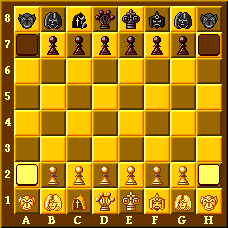 White::
White::
King e1; Queen d1; Ape a1, h1; Courtesan b1, g1; Monk c1; Samurai f1;
Chakra a2, h2; Pawn b2, c2, d2, e2, f2, g2.
Black::
King e8; Queen d8; Ape a8, h8; Courtesan b8, g8; Monk c8; Samurai f8;
Chakra a7, h7; Pawn b7, c7, d7, e7, f7, g7.
The two chakra's of a player are forming together a `transmitter'.
Movement of the pieces
The pieces move in the following ways:- The King moves like the King in Chess.
- The Queen moves like the Queen in Chess.
- The Samurai combines the moves of King and Rook.
- The Monk combines the moves of King and Bishop.
- The Ape moves like the Knight in Chess.
- The Courtesan moves like the King in Chess, but she has an additional power: whenever a Courtesan can 'see' her own King along an open rank, file or diagonal, she controls the whole length of it. This is illustrated in the next two diagrams.
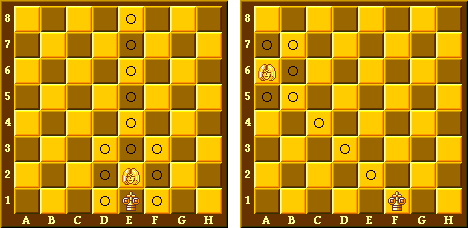
- The pawn moves like the pawn in Chess, except that it cannot capture en passant. It promotes upon reaching the back-rank to any captured piece, except the Transmitter. If no captured piece is available, a pawn may not promote. However, if a pawn attacks a King on the eighth rank, no piece being lost by its side, it nevertheless gives check.
The transmitter
The two chakra's of a player form together a transmitter. One could view the transmitter as a piece consisting of two parts that are located at different squares of the board. In some respects, a chakra is a piece itself, but it is basically a square.A chakra has two sides: a `knight' side and a `king' side. Depending on which side is up, the chakra could either move as knight or as king. In the diagrams this is not indicated. In actual play small ideograms are used on either side. Chakras start out in the Knight's move mode.
A chakra may move, provided it is unoccupied, but cannot capture. Moving a chakra constitutes a turn. It moves according to which side is up. After the move a chakra may be reversed as part of the same turn. It is also permitted to reverse a chakra without moving it, at the cost of a turn.
Any piece, except a chakra, may move onto a vacant chakra as if it were a normal square. Any piece can capture a piece on a chakra as if it were a normal square.
There are special conditions for the King which will be pointed out. For the moment we'll consider the Transmitter's fundamental property:
Whenever a piece can formally move onto a vacant chakra of its own color, it may move onto the other by definition. The second chakra must either be vacant or occupied by an opponent's piece which, then, is captured.
If a piece occupies a friendly chakra and covers (i.e. may move to) the other, it may by definition 'move' to its own square. In other words, the player may in such a case pass his turn. This is shown in the next diagram, where the white Ape may capture the pawn, and where the black Ape is in a position that allows black to pass his turn by 'moving' via g6 back to f4.
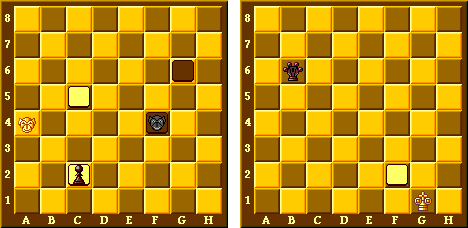
Apart from its ability to move, a chakra is a piece in one more respect:
A piece may move onto, but not over an opponent's chakra. Thus a chakra may, for instance, interpose in case of check, see the second diagram above, where white is not in check. This ability should not be underestimated. Unlike other pieces, an interposing chakra cannot, as a rule, be captured.
In every other respect chakras are squares rather than pieces, and a player may move over his own chakras as if they weren't there. A chakra of either color doesn't affect the eye-contact between a King and a Courtesan, although an opponent's chakra of course creates the obligatory stop mentioned above.
A Transmitter can only be captured by the King. He does so by capturing a vacant chakra. The Transmitter is one piece in this respect: if one chakra is captured the other one is removed simultaneously (if the second chakra is occupied, it is removed from under the piece; the piece itself remains in place). There's one exception to this rule: if a King occupies a friendly chakra, the opponent's King can neither capture the Transmitter nor move onto the other chakra.
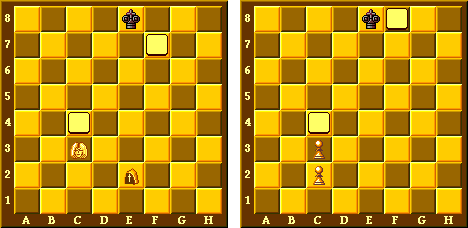
In the diagrams above, if it were black's turn, the King could capture the Transmitter, even if the far chakra were occupied by any piece except the opponent's King. It's supposed to be white's turn, however, and in the left diagram both Courtesan and Monk cover the chakra on c4. By the Transmitter's property either may therefore move to f7, giving check under the other's cover. If f7 were occupied by a black piece, this piece would at the same time be captured. If c4 were occupied by a black piece, both Courtesan and Monk could capture on c4, but the Transmitter could not be used because the vacancy condition would not be fulfilled.
In the diagram on the right, c3-f8 is an instant promotion, say a Queen. The King may not capture it, because it is still under the cover of the pawn on c2, which means he would move into check. This is an important implication to realize: a pawn that uses the Transmitter, captures the same way it moves!p Getting a protected or unattacked chakra onto the back rank and the other in front of a pawn, in order to promote instantaneously, is a key-strategy in Chakra.
Top left, top right and bottom left: a sequence of moves illustrating various points concerning King and Transmitter. In the first diagram the black King may capture the pawn. If he does, white's Tc3-e2 shows a King to King check in the only possible way: through the Transmitter (top right). Black must leave the chakra, but precisely in doing so attacks the Transmitter. White can of course move the attacked chakra, but he has also the option Kf1-e2, occupying the other chakra and therewith protecting the Transmitter (bottom left).
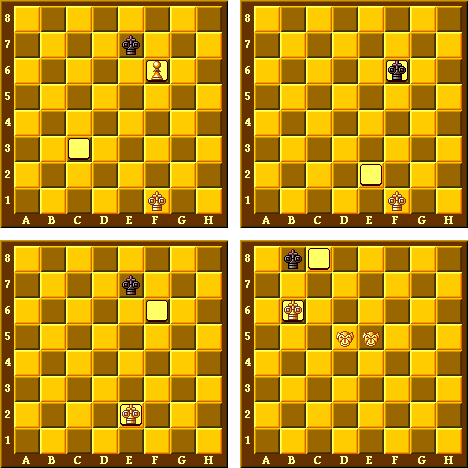
The bottom right diagram shows an implication of the latter principle: in Chess two Knights and a King cannot checkmate a lone King. But with the help of a Transmitter two Apes can.
Rules written by Christian Freeling for the Mindsports website, slightly edited for the Chess Variant Pages by Hans Bodlaender. Introduction written by Hans Bodlaender. Rules and images copyright Mindsports; used here with permission.
WWW page created: March 31, 1998. Last modified: April 6, 1998.